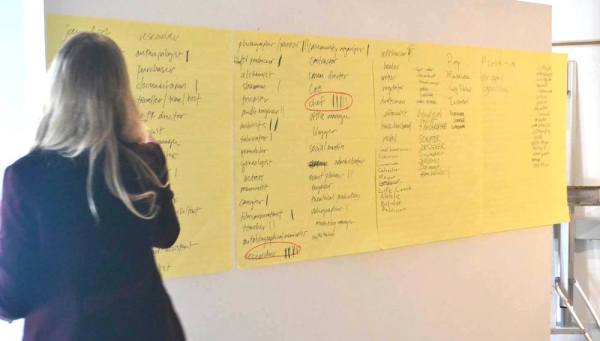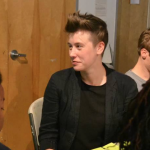Artists!
You’ve just spent a week installing your show at a nonprofit art space and you realize that everyone helping you, from the director down to the part-time preparator and the gift shop clerk, is getting paid for his or her time, and you’re not. Does it seem unfair? Stand up for your rights as an art-worker! You deserve to be paid like everyone else.
If you didn’t bring this sense of outrage to the Charge Practicum at the Art League Houston last weekend, you probably left with it. Activism was the watchword as presenters from Houston and across the country picked at the scabs covering the unhappy truths about artists and money.
Most of the issues raised are old bones, gnawed in the last wave of artist-pay activism in the 1970’s, focusing on the many ways artists allow themselves to be used by museums, schools, and nonprofits as cheap labor to create their programming.
It’s all true, of course. Every practicing artist has experienced the types of exploitation outlined at the conference and a few more. Nevertheless, in a field as wide-open as contemporary art, where anyone can do anything and be taken seriously, and where the compensation is so laughably low that it’s difficult to imagine anyone tied to their art career by a paycheck, there is just no compulsion to submit to maltreatment. If you don’t like the rules, there’s almost nothing to stop you from picking up your marbles and starting your own game.
The most interesting presenters at the Charge Practicum were doing exactly that, and it turns out that Houston is ahead of the national curve on engineering alternatives to an unsatisfactory gallery/museum/nonprofit complex.
Robert Pruitt and M’Kina Tapscott described H.O.S.T., a deeply but quietly subversive Houston project that organizes studio tours aimed at connecting collectors and artists directly, cutting out the middleman. They also outlined the H.O.S.T.-sponsored Gimme the Loot grant, $1000 given annually to a Houston artist of color.

photo: Ronald Jones
Ayanna Jolivet McCloud described her open-ended Houston enterprise Labotanica in poetic terms, touching on artists as entrepreneurs, rethinking art, reciprocity, latitudes, soulfulness, uncertainty, fragility, and failure. Her workshop talked about how to embody these qualities in an institution.
Gabriel Martinez talked about the limits of running an art space with zero budget, and the joys of not having to answer the usual questions charity nonprofit spaces face. He described Alabama Song, an art nexus he runs out of his house in Houston, as a community, held together by the very limitations that the small physical space and negligible budget enforce.
Serial instigator Zach Moser told the story of his wildly successful projects: Workshop Houston (which was presented the 2014 National Arts and Humanities Youth Program Award by First Lady Michelle Obama earlier this week!), The Big Parade, and of Shrimp Boat Projects, drawing parallels between the exploitation of commercial fishermen and artists.
The conference drew several out-of-towners, and their approaches varied strongly by region. New Yorkers were more negative, focused on reforming existing institutions rather than bypassing them.

W.A.G.E. minimums
Lise Soskolne, the star of the weekend, is prime mover of W.A.G.E. (Working Artists in the Greater Economy). She presented the group’s recently released guidelines for minimum compensation of artists by nonprofit art institutions. Her damning facts and figures were guaranteed to make most nonprofits look like sweatshops, and artists like schmucks for submitting to them. Even I was ready to join the union.
Lauren van Haaften-Schick and Helena Keeffe’s Gauging the Grey Area: A Human Spectrum workshops aimed at empowering artists to say “no!” to substandard opportunities offered them, and to hold out for better deals.
Aay Preston-Myint, of Chances Dances, a floating queer dance party/arts granting organization, is based in Chicago, another secondary art center. The similarity of his non-specific community-centered project to those of the Houston artists suggests that responses to dissatisfaction with the established system vary strongly by region. New Yorkers want a piece of the pie; in Houston, Chicago and Pittsburgh artists are baking their own pies.

Dawn Weleski’s Co-dependency Anonymous workshop was a twelve-step program helping people free themselves from traditional art-world definitions of their practices. She showed artists how to re-define what they do in context of the broader culture and take advantage of opportunities for funding beyond the traditional art system. She’s from Pittsburgh.

Alison Gerber
The most thought provoking of the presenters was Alison Gerber, a Yale PhD sociologist who studies how artists value their practices. An enthusiastic lecturer, she revealed some of her surprising findings in non-technical terms, providing more new insights into the artist/money relationship in her forty minutes than the rest of the weekend’s presenters combined. Essentially, she said, art is in a transition similar to that happening in politics and childcare, where professionalized paid workers work side by side with unpaid volunteers, doing many of the same jobs, some for love, others for money. The tension between these two views of the proper motivation for art work gives rise to the uncertainties, inequities, and anxieties that the Charge Practicum tried to address.
Charge was co-organized by Jennie Ash of Art League Houston and Houston artist Carrie Schneider, inspired by Valuing Labor in the Arts: A Practicum presented by The Arts Research Center (ARC) at UC Berkeley last April. It took place on November 8-9, 2014.



7 comments
I’d like to see a piece done on the countless photo contests that charge for submitting photos. They are all over the inter-webs put out by organizations with very official sounding titles. Seems like a case of artist paying someone as opposed to just being used… I can’t believe this is becoming normal or an accepted way for photographers to get into shows…
Rene: Very much agree with you. Pay per entry contests are a total sham.
I was president of the board of a non-profit gallery here in Beaumont for about three years.
Artists charging galleries a fee to exhibit is just laughable. We LOST money on EVERY solo and group show. They aren’t money-makers. We did them to support the local artists by giving them an opportunity to exhibit their work and the local community a chance to get to know them.
We crossed our fingers that commissions on sales would pay the bills that month, but it never does. We make up the funding through competitive shows, grants, memberships, donations, and fundraisers.
As an artist myself (thankfully not full-time or I really would starve), I understand the work and expense that goes into a solo show, and the frustration of not even breaking even. But blaming the non-profit galleries of being “sweatshops” is, frankly, offensive.
Rather than making non-profit galleries out to be the enemy, perhaps Ms. Soskolne should volunteer to be on the board of one for a few years and see how much they do *for* artists. Not some high-falutin’ gallery space propped up by a bulky endowment either — she should pick a scrappy nonprofit that runs a full-time gallery space (not a temporarily-converted abandoned building “gallery” worthy of a mention by SNL’s Stefon) with an operating budget of under $100k a year. Until then, I don’t think she has any room to talk.
I’m all for alternative business models, but you can’t bleed a turnip. Galleries cost money to run.
Please correct me if I am wrong Mr. Tallent, but isn’t a gallery dependent on art sales a commercial gallery?
according to 501 (c)-3 status requirements:
“Rev. Rul. 76-152, 1976-1 C.B. 152
Art gallery. A nonprofit organization formed by art patrons
to promote community understanding of modern art trends by
selecting for exhibit, exhibiting, and selling art works of local artists, retaining a commission on sales less than customary commercial charges and not sufficient to cover the cost of operating the gallery, does not qualify for exemption under section 501(c)(3) of the Code; Rev. Rul. 71-395 clarified. ”
How did your non profit gallery maintain it’s 501(c)(3)status?
How about some artists on the panel that are actually making money from their artwork like John Palmer, James Surls, David Adickes and/or Dixie Friend Gaye, etc? Put someone in front of me that can tell me about making a $100k or a $1M vs $1k. A grand covers the cost of me thinking about a project not alone trying to do one. That’s the same “nonprofit” thinking that keeps artists struggling. Nice try for the artist pulling it together and great cause. I give you an E for effort but if you do this again please find some artists that are actually making money from their art vs. artists who work other jobs to pay the bills. Artists must thrive not just survive.
I’d be in that workshop.
Why can’t i get a free handout to do what i love?
Earn your way in this world, folks.